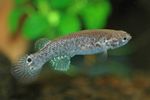Publication details
The Genome of the Self-Fertilizing Mangrove Rivulus Fish, Kryptolebias marmoratus: A Model for Studying Phenotypic Plasticity and Adaptations to Extreme Environments. (2016)
Genome Biol Evol 8, 2145-2154.
Kelley JL, Yee MC, Brown AP, Richardson RR, Tatarenkov A, Lee CC, Harkins TT, Bustamante CD, Earley RL
Abstract: The mangrove rivulus (Kryptolebias marmoratus) is one of two preferentially self-fertilizing hermaphroditic vertebrates. This mode of reproduction makes mangrove rivulus an important model for evolutionary and biomedical studies because long periods of self-fertilization result in naturally homozygous genotypes that can produce isogenic lineages without significant limitations associated with inbreeding depression. Over 400 isogenic lineages currently held in laboratories across the globe show considerable among-lineage variation in physiology, behavior, and life history traits that is maintained under common garden conditions. Temperature mediates the development of primary males and also sex change between hermaphrodites and secondary males, which makes the system ideal for the study of sex determination and sexual plasticity. Mangrove rivulus also exhibit remarkable adaptations to living in extreme environments, and the system has great promise to shed light on the evolution of terrestrial locomotion, aerial respiration, and broad tolerances to hypoxia, salinity, temperature, and environmental pollutants. Genome assembly of the mangrove rivulus allows the study of genes and gene families associated with the traits described above. Here we present a de novo assembled reference genome for the mangrove rivulus, with an approximately 900 Mb genome, including 27,328 annotated, predicted, protein-coding genes. Moreover, we are able to place more than 50% of the assembled genome onto a recently published linkage map. The genome provides an important addition to the linkage map and transcriptomic tools recently developed for this species that together provide critical resources for epigenetic, transcriptomic, and proteomic analyses. Moreover, the genome will serve as the foundation for addressing key questions in behavior, physiology, toxicology, and evolutionary biology.
| Kryptolebias marmoratus RHL |
[ Opisthokonta | Metazoa | Eumetazoa | . . .
. . . | Aplocheiloidei | Rivulidae | Kryptolebias ]
 Courtesy of F.Vermeulen
Courtesy of F.Vermeulen
|
Genome files Show genomes |










